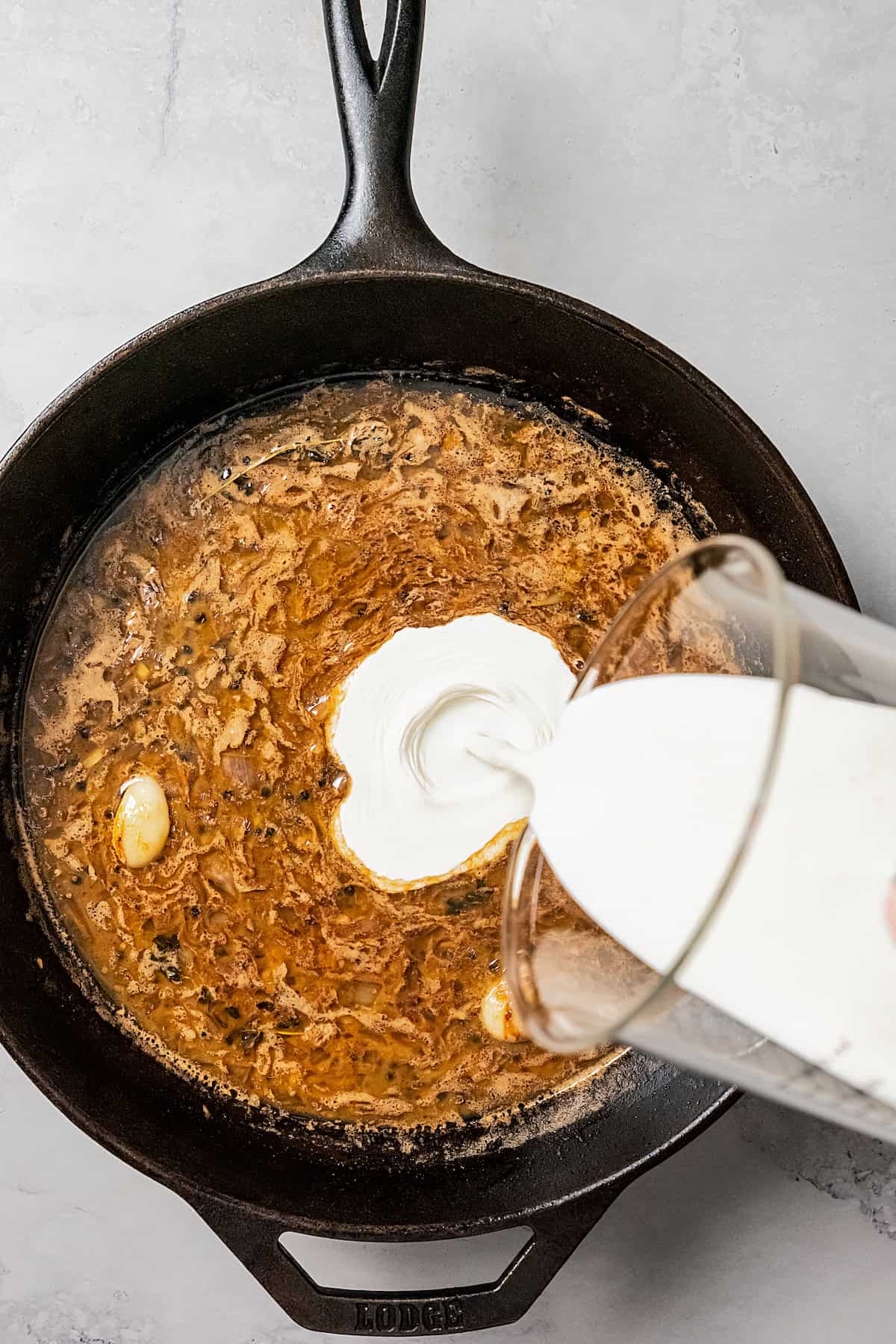This post may contain affiliate links. Please read our disclosure policy.
Steak au poivre, or pepper steak, is a French bistro favorite with so much flavor! Juicy filet mignon gets crusted with tongue-tingling cracked pepper and pan-fried, then served with a boozy, creamy pan sauce.
This easy skillet recipe uses the same technique as my quick steak with mushroom sauce and bourbon steak. C’est magnifique!

Steak au poivre (pronounced “steak oh pwah-vruh”), or pepper steak, is a classic French recipe for pan seared filet mignon crusted with cracked peppercorns. I like to think of it as a big, juicy bite of Paris on a plate! The steak is pan-fried before we turn the leftover juices into a silky poivre sauce with pepper, cognac, and cream. Just add a side of crispy fries or garlic parmesan potatoes and steamed veggies for a steak dinner like you’ve never had before!
I first made this steak recipe years ago from a French cookbook, and while it was delicious, the one we had in Paris was absolutely the best! Few years ago, Goce and I were wandering the Parisian streets right before catching a soccer match to see Paris Saint-Germain play. We sat at this little bistro and the waiter recommended the steak au poivre. As we gobbled down each bite, with the rich au poivre sauce perfectly complementing the tender steak, we knew we had to have this magic at home, on repeat.
Why You’ll Love This Steak au Poivre Recipe
- Peppercorn sauce. Filet mignon might sound fancy pants, but the real standouts in this recipe are the pan sauce and peppercorns! Black pepper and booze brighten up the cream sauce without overpowering the steak.
- One pan. I LOVE steak recipes like smothered steak that I can make in one pan in under an hour. This pan-seared steak au poivre takes 45 minutes from start to finish, and the results are totally bistro-worthy!
- Back-to-basics. Home cooked steak au poivre is easy to prepare using basic cooking techniques that you’ll carry into future recipes. Everyone should know how to pan-sear a good steak, and knowing how to make a simple pan sauce is a game-changer.

Ingredients You’ll Need
“Au poivre” is a French term for a dish prepared with a good amount of cracked pepper. In this case, it’s steak with peppercorn sauce. Below are some quick notes on what you’ll need to make it. Scroll to the recipe card for a printable list with the amounts and recipe details.
- Peppercorns – The type of peppercorns you use will impact the dish’s overall flavor (see below). The key is to use coarsely crushed pepper, not finely ground.
- Olive Oil and Butter – Oil for sautéing the steak, and butter to baste the meat as it cooks. You can use salted or unsalted butter.
- Garlic – You’ll need whole garlic cloves when basting the steak, plus minced garlic for the au poivre sauce.
- Thyme – Fresh thyme sprigs round out the flavors without overpowering the pepper.
- Shallot – Or a small yellow onion, finely chopped.
- Cognac – If you don’t have cognac, your next best bet is brandy.
- Heavy Cream – You can substitute half-and-half, though the sauce won’t be quite as rich and creamy.
- Parsley – Chopped fresh parsley for garnish.


What Kind of Pepper Is Best for Steak au Poivre?
I use cracked black peppercorns, but you can also use white, green, pink, or Sichuan peppercorns for a more tingly sensation. Or, use a mix of different peppers to create a unique flavor. I like to use a pestle and mortar to crack the peppercorns as it gives better control over the grind.
Which Cut of Steak Should I Use?
Traditional steak au poivre recipes use filet mignon, part of the beef tenderloin. However, this recipe turns out great with New York strip steaks, sirloin, or rib-eye, too. Just keep in mind that the cooking times will vary, so have a meat thermometer on hand to check the steaks for doneness.
How to Make Steak au Poivre
This steak dinner is a bit like my pan-seared steak with cognac sauce, and the method is very similar. Here’s how to make this bistro-style steak au poivre in a few easy steps:






- Cook the steak. First, pat dry the filet mignon and get the meat coated with salt and peppercorns on both sides. Get the steaks searing in a large pan with oil.
- Baste. After 6 minutes, flip. Now, you’ll drop a couple of spoonfuls of butter in the pan, plus garlic cloves and thyme. Spoon the melted butter over the steaks while they finish cooking. Afterward, rest the filets while you make the sauce.
- Make the sauce. Next, in the same pan, sauté shallot and garlic. Deglaze the pan with cognac, and finally, lower the heat and stir in the cream. Simmer to thicken, and then serve the pan sauce over the beef along with a sprinkle of fresh parsley.
Use the Right Pan
The best pan for cooking steak is a heavy-bottomed cast-iron skillet or frying pan. Cast iron heats through evenly and is easiest to clean. If you ask me, it’s worth the investment! I use my cast-iron pan in so many recipes, from getting the perfect sear on this filet au poivre to ribeye steak and oven grilled steak. (Did I mention it goes from stovetop to oven?!)

Recipe Tips
- Room temperature steaks. Take the steak(s) out of the fridge at least 20 minutes and up to an hour before you plan to cook them. This will help the steaks cook evenly and ensure the pepper sticks perfectly to the meat.
- Use a meat thermometer. Cook the filet mignon to your desired doneness (I recommend aiming for 120-125°F initially, allowing the carryover heat to bring the steaks to a perfect medium-rare at 130-135°F). Once done, place the steaks on a plate and tent them with foil.
- Size matters. For the best results, get steaks that are the same size and thickness. This ensures they cook evenly. If your steaks vary in size, you’ll need to check the temperature of each one and possibly remove them from the oven at different times.
Serving Suggestions
Typically, steak au poivre is served with some form of potatoes, whether they’re mashed or turned into French fries. To keep things light, I pair it with a side of fresh greens, like this Mediterranean salad or a simple arugula salad. This fresh zucchini salad is also great during the zucchini season!
The peppery flavors of the steak also go well with roasted vegetables and lemon butter green beans. And to round out the meal, treat yourself to my black magic chocolate cake for dessert!

Storing and Reheating Leftovers
Steaks are best if served immediately. If you have leftovers, place the steak and sauce in an airtight container and keep them in the fridge for up to 3 days or freeze for 2 to 3 months. Defrost in the refrigerator before reheating.
To reheat, I prefer to warm the steak au poivre in a covered skillet until it’s heated through. Be careful that you don’t overcook the steak while reheating.
More Steak Recipes
- Flank Steak Peperonata
- Coulotte Steak Recipe
- Steak and Eggs
- Marinated London Broil
- Stuffed Flank Steak
Pin this now to find it later
Pin It
Steak au Poivre
Ingredients
- 4 filet mignon steaks, 6 to 8 ounces each
- 4 teaspoons salt
- ¼ cup crushed peppercorns
- 2 tablespoons olive oil
- 5 tablespoons butter, divided
- 3 cloves garlic, whole
- 3 sprigs fresh thyme
- 1 small shallot, finely chopped
- 2 cloves garlic, minced
- ⅔ cup cognac
- 1½ cups heavy cream
- ¼ cup chopped fresh parsley
Instructions
- Season the meat. Pat the filet mignon dry and allow it to sit at room temperature for 20 minutes. Season the beef (on both sides) with salt and press the peppercorns into both sides of each filet.
- Sear. Heat the olive oil in a large cast iron skillet or heavy-bottomed frying pan over medium-high heat. Add the steak to the pan and sear for 6 minutes. Flip the filets.
- Baste. Add 2 tablespoons of butter to the pan along with the garlic cloves and thyme. Continue cooking the steak for 5 more minutes or until a meat thermometer inserted into the largest steak reads 125°F to 130˚F. All the while, spoon the melted butter over the steaks periodically.
- Rest. Transfer the filets to a serving platter and set aside.
- Saute the veggies. Reduce the heat to low and add the remaining butter to the same pan you cooked the steak in. Once the butter has melted, add the shallot. Saute until translucent. Add the garlic and saute for 15 seconds or until fragrant.
- Deglaze. Add the cognac to the pan and cook for 1-2 minutes, stirring occasionally.
- Make it creamy. Turn the heat to low and stir in the heavy cream. Simmer until the sauce has thickened to your desired consistency.
- Serve. Pour the sauce over the steaks, garnish with fresh parsley, and serve.
Notes
- Crush the whole peppercorns using a mortar and pestle.
- Don’t overcook the filet mignon; to prevent it from becoming dry, use a meat thermometer to check for doneness. I suggest aiming for an internal temp of 120-125°F, letting the carryover heat raise the steaks to a medium-rare of 130-135°F while they rest.
Nutrition
Nutritional info is an estimate and provided as courtesy. Values may vary according to the ingredients and tools used. Please use your preferred nutritional calculator for more detailed info.









As an amateur I found this recipe simple to follow, and it made the most beautiful meal for my wife and myself!
By following the recipe, even I couldn’t get it wrong!
The BEST MEAL I’ve ever prepared! A huge THANK YOU!!!
Thank you so much! I’m thrilled to hear it turned out so well, and that you both loved it. Your kind words mean a lot! 🙂